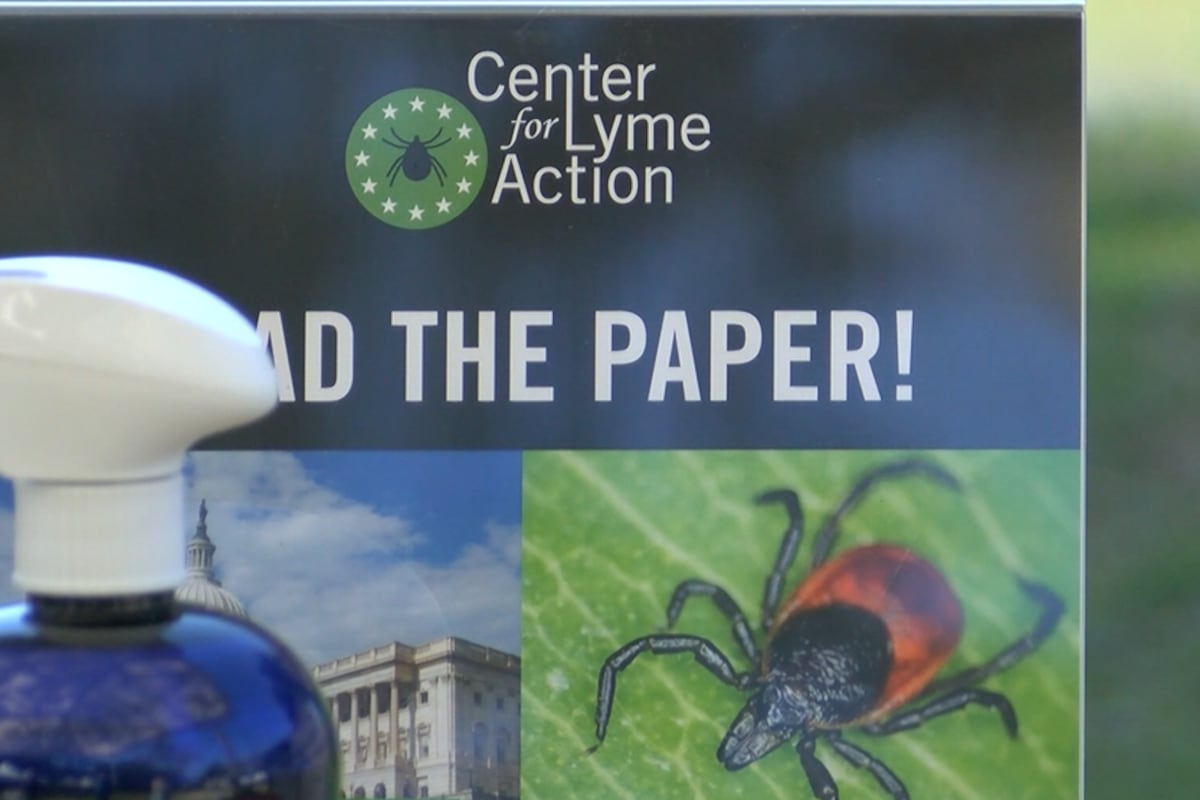Lyme-A-Palooza raises awareness and funds for Lyme disease in SC
MOUNT PLEASANT, S.C. (WCSC) - As the weather starts to heat up and the sun starts to emerge, so do bugs, more specifically, ticks.
Ticks are most active from March to November, according to The South Carolina Department of Public Health.
A Lowcountry woman is working to raise awareness about the dangers of ticks by organizing a music festival aimed at educating the public and raising funds for Lyme disease research in South Carolina.
Sarah Bolden organized Lyme-A-Palooza in partnership with Project Lyme, a nonprofit dedicated to eradicating tick-borne diseases through awareness and education.
Lyme-A-Palooza debuted in Mount Pleasant on Saturday outside at Mainland Container Co. Kitchen and Bar.
The inaugural event featured live music, food, vendors, and educational booths.
This journey for Bolden began 12 years ago when she was bitten by a tick in South Carolina.
She said this life-altering occurrence led to years of delayed diagnoses and limited treatment options, an experience that ignited her passion for raising awareness in the Charleston area.
Meghan Bradshaw, a Lyme disease survivor who attended the festival, has dedicated her life to raising awareness not only about the risks and symptoms of Lyme disease but also about the broader socio-economic and social challenges associated with it.
Bradshaw shared she was in her early 20s when she returned to her parents’ home in Charlotte, North Carolina, for what she believed would be a short medical leave to recover from a torn meniscus. Instead, she became bedridden for three years and required 24/7 care.
“One of the challenging things is that this is a largely invisible illness. There’s many patients who have symptoms that wax and wane. So, maybe one day you’re having struggles getting out of bed and functioning and taking care of yourself in daily activities and then the next day you’re feeling up to maybe walking your dog. That’s where it’s really challenging because they may come and go, but it’s certainly something that many patients experience as a challenge with living with invisible illness,” she said.
By age 26, she had undergone bilateral hip replacement surgery. The cause? Lyme disease and other tick-borne infections that went undiagnosed for years.
“Following that, I learned that I had Lyme and tick-borne diseases, and that is what had been wreaking havoc on my body for the years leading up to this. Unfortunately, I had been earlier, I had been misdiagnosed…There are a lot of myths about where and when and how you can track tick-borne diseases, and I think public awareness is a huge thing. Human health behavior is going to be our best strategy for prevention and reducing the burden of this disease, but we also need things like insurance coverage for patients,” she said.
Initially misdiagnosed with rheumatoid arthritis, Bradshaw said she followed a regimen of steroids and immunosuppressive drugs. The treatment worsened her condition, accelerating joint deterioration.
“My functional level was like someone who had a spinal cord injury. I was really at the point where I couldn’t even feed myself, dress myself or bathe myself,” she said.
Bradshaw’s journey reflects a larger issue in Lyme disease diagnosis and treatment. She said many patients, like her, see multiple specialists before getting answers.
“When I couldn’t get out of bed when I was in my early 20s, that was a pretty big indicator. But I had been searching for a diagnosis for upwards of a decade. I had been tossed around to tons of different specialists,” she said.
Now, after her tenth joint replacement, she said she’s earned the nickname, “The Bionic Woman” in her community. Today, she is back on her feet and advocating for change in Washington, D.C., where she works as the Government Relations Manager for the Center for Lyme Action.
“Many people don’t realize that Lyme is the most prominent and fastest growing infectious disease in the United States, and there’s nearly half a million new cases of Lyme disease every year in the U.S. alone- that’s not accounting for the dozens of other tick-borne diseases that exist in the U.S., and so this is a big challenge as it’s growing and many people are not aware,” Bradshaw said.


She explained that factors such as deforestation and shifting migratory animal patterns contribute to the growing tick populations, increasing the risk of bites.
“As we’re continuing to build in tick habitats, many folks are not realizing that maybe their new development is on land that is a natural tick habitat. So you may walk right off your patio and into your backyard and you can acquire a tick bite right there. So, that’s a big challenge that a lot of people are not realizing it’s right in your own backyard,” Bradshaw said.
Dr. Penni Vachon, a nurse practitioner and owner of Lowcountry Wellness Center in Charleston, specializes in Lyme disease treatment and said she’s seen firsthand the rise in cases not just across the country, but right here in the Lowcountry.
“We have a practice of almost a thousand patients, and if we just look at the statistics in America that say that approximately over 80% of Americans have Lyme disease, then there would be approximately about 800 patients in my practice with Lyme disease,” she said.
Vachon said there are multiple ways to test for the disease, noting that symptoms vary from person to person and that testing methods depend on individual circumstances.
“We don’t always have to test. Lyme disease is what we call a diagnosis of inclusion. So, it’s just, do you meet the criteria for it? I’ll typically only test if somebody really wants to test or if we’re going to go down a particular treatment pathway that requires that I have a Lyme test. Everything else, we just make the assumption that you have it and I treat based on that,” she said.
Vachon said her practice uses a mix of treatments, including herbal and botanical therapies, alongside alternative methods like light and sound therapy.
“I think as more awareness gets out, more people are starting to realize that, oh, wait, this isn’t Fibromyalgia, it’s not just MS, it’s not just migraine disorder… I tell everybody, you know, I have such good, bad news for you. The good news is I know what’s wrong with you, and you’re validated, you’re seen, you’re heard, your symptoms are real, your concerns are legit. The bad news is it’s Lyme disease. The good news is we’ve got treatment options for it, but it’s a lifelong disease,” she said.
Vachon, who has Lyme disease herself, shared that she attended Lyme-A-Palooza to help raise awareness and make the disease as widely recognized as diabetes or high blood pressure.
“I think first we have to address the misconception that Lyme disease only comes from a tick- it doesn’t. It’s a vector-borne illness; it comes from anything that draws blood. So, ticks, gnats, no-see-ums, mosquitoes, fleas; All of it has the potential to carry Lyme,” she said.
As temperatures continue to rise and more people head outdoors, Bradshaw and Vachon urge the public to take precautions.
“We’ve got to spread the news; everybody needs to know because it truly impacts everybody. I mean, think about 10 people in your life. Chances are eight out of 10 of them have Lyme disease and maybe one of them knows it,” Vachon said.
“Unfortunately, there’s a lot of misconceptions and inadequate provider education. And so it’s really important that folks are keeping this at the forefront of their minds, especially as we’re enjoying this beautiful weather and the outdoors, that a tick bite might be the culprit of your mystery illness,” Bradshaw added.
Bradshaw emphasized that ticks can be as small as a poppy seed, making it essential to thoroughly check yourself and your pets for ticks after spending time outdoors, especially because many bites will often go undetected.
“When you get a tick bite, essentially, you’re getting a mixed bag of whatever that tick has already acquired from feeding on another mammal. So, it’s kind of like you get a surprise mix. And unfortunately, each of those combinations may cause the patient’s presentation to look very different,” Bradshaw said.
The South Carolina Department of Public Health says Lyme disease symptoms include a bull-eye rash at the site where the tick was attached, fever, headache, fatigue, muscle or joint pain, and fever and flu-like symptoms.
Bolden’s goal was to raise $2,000 for Project Lyme and according to their website, the festival has raised more than $2,600.
Copyright 2025 WCSC. All rights reserved.













